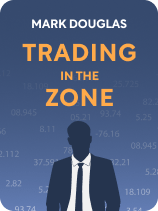

This article is an excerpt from the Shortform book guide to "Trading in the Zone" by Mark Douglas. Shortform has the world's best summaries and analyses of books you should be reading.
Like this article? Sign up for a free trial here .
Are you an overly careful trader? Why is it important to embrace risk in trading?
To achieve consistent profits in trading, it’s essential to embrace risk. According to Mark Douglas, the author of Trading in the Zone, you must be comfortable with risk to ward off irrational fears that corrode your trading mindset and your potential to profit.
Let’s look at the factors that cause us to avoid risk and develop an unhealthy relationship with the market.
What Embracing Risk Really Means
According to Douglas, embracing risk in trading means accepting the possible outcomes of your trades without fear or regret—even negative outcomes. Remember: 95% of trading errors stem from our fears about losing money, being wrong, or selling investments prematurely and therefore missing out on maximum profits. So, to achieve consistent success, you need to be mostly free of fear and related emotions like anger, bitterness, and frustration.
(Shortform note: Although Douglas says we should seek to eliminate fear to trade successfully, others say fear of failure may be helpful in achieving success as a trader. Ray Dalio, founder of Bridgewater & Associates (the world’s largest hedge fund), says he always works out the worst-case scenario in any trade so he can take all appropriate steps to minimize potential loss.)
Misguided Goals and Irrational Fears Cause Us to Avoid Risk
Douglas acknowledges that getting rid of fear can be challenging. After all, the stakes in trading are often very high. Being wrong about a trade and losing money can cause emotional pain and financial ruin. But, Douglas asserts, we need to recognize that our fears are irrational and stem largely from misguided goals that cause us to see the market as a threat. These misguided goals include fulfilling an addiction to intermittent variable rewards, impressing people in our social network, being a savior for our family, and getting a blissful high from winning.
According to Douglas, if we’re motivated by these goals—even just a little—we’ll interpret any market information that indicates we’re wrong as painful. Why? Because by tying our happiness, fulfillment, status, and identity to positive market outcomes, we experience any indication that our goals won’t be fulfilled as a personal threat.
(Shortform note: Is Douglas right that most traders have misguided goals that lead them to see the market as threatening? It’s impossible to know the private goals of all traders. However, research shows that many traders claim to have healthier and more productive goals for investing—everything from compiling savings for retirement, to ensuring the financial security of younger generations, to making donations to charities. Others invest to support businesses they align with ethically. For example, some investors only support businesses with robust environmental initiatives.)
When we perceive the market as a threat, we’re driven by fear to do everything we can to prevent pain (by avoiding risk and losses). We’ll—consciously or unconsciously—second guess our analyses, miss prime buying moments, hesitate to take profits when we should, hold onto losing stocks way too long, and distort or ignore information that goes against our predictions. Meanwhile, Douglas explains, opportunities to cut our losses or make money pass us by. Thus, efforts to avoid risk and pain virtually guarantee failure. Although we might achieve an occasional win, we won’t be consistent winners.
| Cognitive Biases That Hamper Critical Thinking Are trading errors due exclusively to risk-avoidance behaviors stemming from fear, as Douglas claims? Perhaps not—investment experts point to other potential sources of trading missteps, including two common cognitive biases. Availability bias occurs when we draw conclusions based on the information that’s most readily available to us—but it’s often inaccurate. For example, if we see a series of news reports trumpeting Company A’s release of a new product, we might feel compelled to buy Company A’s stocks under the assumption that prices will climb. Our positive interpretation will persist even if we learn that deeper market analyses reveal declining stock values. Another bias that causes us to make errors is loss aversion, which is the tendency to view loss as more significant than an equivalent gain. Because we hate loss so much, we actively avoid experiencing it. Therefore, we cling to losing trades and refuse to cut our losses, wishfully thinking the trade will inevitably come back in our favor. This ultimately results in even more significant losses that we could have avoided had we admitted defeat sooner. As these examples suggest, it’s important to examine the motives behind your trading decisions, as Douglas recommends, so you can achieve consistent success. |

———End of Preview———
Like what you just read? Read the rest of the world's best book summary and analysis of Mark Douglas's "Trading in the Zone" at Shortform .
Here's what you'll find in our full Trading in the Zone summary :
- The role mindset plays in stock trading
- The critical importance of embracing risk
- How to become a confident, consistent winner






